
Bingham is a market town and civil parish in the Rushcliffe borough of Nottinghamshire, England, 9 miles (14 km) east of Nottingham, 12 miles south-west of Newark-on-Trent and 15 miles west of Grantham. The town had a population of 9,131 at the 2011 census.

Aslockton is an English village and civil parish 12 miles (19.3 km) east of Nottingham and two miles (3.2 km) east of Bingham, on the north bank of the River Smite opposite Whatton-in-the-Vale. The parish is also adjacent to Scarrington, Thoroton and Orston and within the Rushcliffe borough of Nottinghamshire. The population was recorded as 974 in the 2011 census.
Alverton is an English hamlet in the Newark and Sherwood district of Nottinghamshire. It is joined by neighbouring Kilvington to form an area for a parish meeting. It contains 22 houses, surrounded by farmland. The River Devon and its tributary, the Winter Beck, run along its eastern border. It is covered by the civil parish of Staunton.
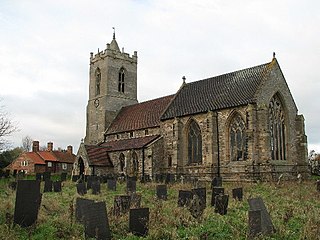
Car Colston is an English village and civil parish in the Rushcliffe borough of Nottinghamshire. The population of the civil parish at the time of the 2011 census was 185.

The Nottingham–Grantham line is a branch line between the city of Nottingham and the town of Grantham in the East Midlands of England. For most of its length it runs parallel to the A52.

Bingham was a wapentake of the historic county of Nottinghamshire, England. It was in the south-east of the county, to the south of the River Trent.

Radcliffe railway station (also known as Radcliffe-on-Trent and Radcliffe (Notts)) serves the village of Radcliffe-on-Trent in Nottinghamshire, England. It lies on the Nottingham to Grantham Line, 5 miles (8 km) east of Nottingham. Services run to Nottingham, Grantham, Boston and Skegness.
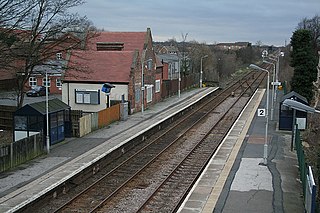
Bingham railway station serves the market town of Bingham, Nottinghamshire, England. The station is 8½ miles (14 km) east of Nottingham on the Nottingham-Skegness Line. The station is operated and served by East Midlands Railway.

Aslockton railway station serves the English villages of Aslockton and Whatton-in-the-Vale in Nottinghamshire. It also draws passengers from other nearby villages. It is 10 miles east of Nottingham on the Nottingham–Skegness Line.

Elton and Orstonrailway station serves the villages of Elton on the Hill and Orston in Nottinghamshire, England. It is owned by Network Rail and managed by East Midlands Railway, but now provides minimal rail services.

Bottesford railway station serves the village of Bottesford in Leicestershire, England. The station is 15 miles east of Nottingham, on the lines to Grantham and Skegness. It is the least used station in Leicestershire.

Granby is a small village in the Rushcliffe district of Nottinghamshire, England. It lies in the Vale of Belvoir.
Whatton-in-the-Vale is an English village in the Nottinghamshire borough of Rushcliffe. It lies in the Vale of Belvoir, with the River Smite to the west and the River Whipling to the east, mainly north of the trunk A52 road, 12 miles (19 km) east of Nottingham. It had a population of 843 at the 2011 census.

Thoroton is a small English parish in the borough of Rushcliffe, Nottinghamshire, with a population of 112. The village has conservation area status. Its Anglican parish church is a Grade I listed building.

Shelton is an English village and civil parish in the Rushcliffe borough of Nottinghamshire. According to the 2001 census, Shelton had a population of 107,. At the 2011 census, the statistics for Shelton included Sibthorpe, and the population was 307. The village lies 8 miles (13 km) south of Newark-on-Trent, on the north side of the River Smite, near where it joins the River Devon. It has no parish council, only a parish meeting.
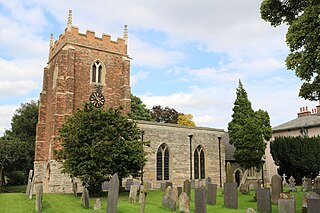
Hawksworth is an English conservation village and civil parish in the Rushcliffe borough of Nottinghamshire. It lies 10 miles (16 km) south of Newark-on-Trent, adjacent to the villages of Flintham, Sibthorpe, Thoroton, Scarrington and Screveton.
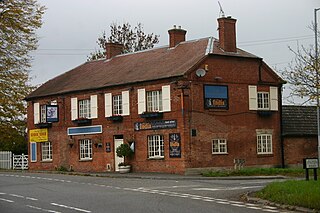
Elton on the Hill is a small Nottinghamshire village and civil parish in the Vale of Belvoir. The population of about 75 is included with the civil parish of Granby for census purposes.

St. Thomas' Church, Aslockton is a late 19th-century Church of England parish church in the village of Aslockton, Nottinghamshire. The church is Grade II listed by the Department for Digital, Culture, Media and Sport as a building of special architectural or historic interest.

Screveton is an English parish and village in the Rushcliffe borough of Nottinghamshire, with about 100 inhabitants, increasing to 191 at the 2011 Census. It was formerly in Bingham Rural District and before 1894 in Bingham Wapentake. It is adjacent to Kneeton, Flintham, Hawksworth, Scarrington, Little Green and Car Colston.
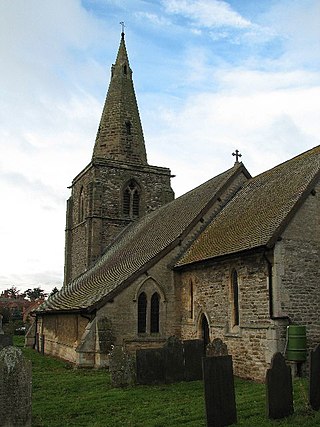
Scarrington is an English civil parish and village in the Rushcliffe borough of Nottinghamshire, adjacent to Bingham, Car Colston, Hawksworth, Orston and Aslockton. Its 973 acres had a population in 2011 of 183. It lies at Ordnance Survey grid reference SK7341 in the undulating farmland of the Vale of Belvoir, some 2 miles (3.2 km) from the town of Bingham and from a stretch of the Roman Fosse Way (A46) between Newark and Leicester. It is skirted by the A52 road between Nottingham and Grantham.


















